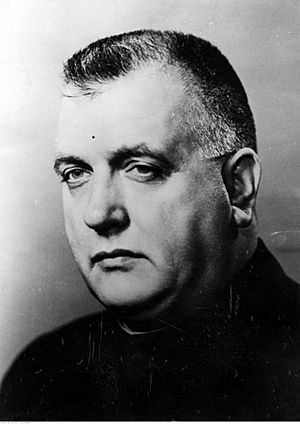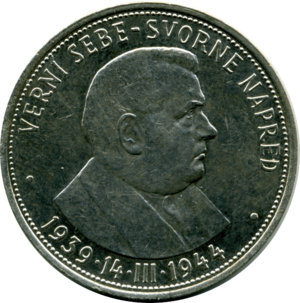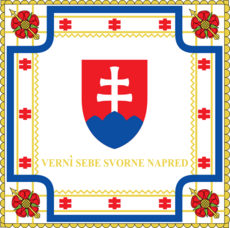Jozef Tiso facts for kids
Quick facts for kids
The Reverend
Jozef Tiso
|
|
|---|---|

Tiso, c. 1936
|
|
| President of the Slovak Republic | |
| In office 26 October 1939 – 4 April 1945 |
|
| Preceded by | Office created |
| Succeeded by | Office abolished |
| Prime Minister of the Autonomous Slovak Region | |
| In office 7 October 1938 – 9 March 1939 |
|
| Preceded by | Position established |
| Succeeded by | Vojtech Tuka |
| Minister of Interior, Social Care and Health | |
| In office 1 December 1938 – 20 January 1939 |
|
| Preceded by | Himself |
| Succeeded by | Himself |
| Minister of the Interior | |
| In office 7 October 1938 – 1 December 1938 |
|
| Preceded by | Office created |
| Succeeded by | Himself |
| Minister of Health and Physical Education of Czechoslovakia | |
| In office 27 January 1927 – 8 October 1929 |
|
| Preceded by | Jan Šrámek |
| Succeeded by | Jan Šrámek |
| Personal details | |
| Born | 13 October 1887 Nagybiccse, Hungary, Austria-Hungary |
| Died | 18 April 1947 (aged 59) Bratislava, Czechoslovakia |
| Cause of death | Execution by hanging |
| Political party | Slovak People's |
| Profession |
|
| Signature |  |
Jozef Gašpar Tiso (1887–1947) was a Slovak politician and Catholic priest. He served as president of the First Slovak Republic from 1939 to 1945. This state was closely linked to Nazi Germany during World War II. After the war, he was found guilty of treason and executed in Bratislava in 1947.
Born in 1887 in what is now Slovakia, Tiso studied several languages. He became a priest and worked to help people in his community. In 1918, he joined the Slovak People's Party. He became the party leader in 1938. On March 14, 1939, Slovakia declared its independence from Czechoslovakia. This happened two days after Nazi Germany took control of the Czech lands.
Jozef Tiso became the prime minister of the new Slovak Republic. In October 1939, he was elected its president. During his time as leader, Tiso's government cooperated with Germany. Many Slovak Jews were sent to camps in Germany and German-occupied Poland. Some were also killed in Slovakia. These actions took place from March to October 1942.
An anti-German uprising began in Slovakia in 1944. It was called the Slovak National Uprising. German forces stopped the uprising. After this, more Jews were sent away. When the Soviet Red Army entered Slovakia in April 1945, Tiso fled. He was later arrested by American troops. He was sent back to Czechoslovakia. There, he was found guilty of serious crimes and executed in 1947.
Contents
Early Life and Education
Jozef Tiso was born in 1887 in Bytča, a town in the Kingdom of Hungary. This area was part of the Austro-Hungarian Empire. He grew up in a religious family. He was a good student and learned several languages. He went to grammar schools in Žilina and Nitra.
In 1902, Tiso began studying for the priesthood in Vienna. He learned about different ideas and studied Hebrew, German, and Latin. His school reports described him as an "excellent" and "pious" student. He became a priest in 1910. In 1911, he earned a degree in theology.
Early Career and Public Service
After becoming a priest, Tiso worked in several parishes in Slovakia. He was interested in public matters. He did a lot of work to help educate people and improve social conditions. He worked against poverty and alcoholism. He also joined a self-help group that sold food and clothes at lower prices.
During World War I, Tiso served as a priest for soldiers. He saw the difficulties of war firsthand. He also learned about how different groups tried to influence local people. Tiso's military service ended because of a kidney illness. He then became a spiritual director at a seminary in Nitra. He also taught at a school and wrote for newspapers. He wrote about his war experiences and the need for good morale. He also wrote about religious topics.
Before 1918, Tiso focused on social and religious activities among Slovaks. He was loyal to the Habsburg dynasty. His writings showed his strong connection to the entire Austro-Hungarian monarchy.
Entering Politics
In 1918, the Austro-Hungarian monarchy collapsed. Tiso realized that the Kingdom of Hungary could not continue as it was. He began to prepare people for a new state. In December 1918, he was asked to help negotiate with the Czechoslovak Army. He was named secretary of the new Slovak National Council. This marked the start of his political career.
Role in the First Czechoslovak Republic
In December 1918, Tiso joined the Slovak People's Party. This party supported democracy. It aimed to protect the interests of Slovak Catholic voters. It also wanted Slovakia to have more self-rule within Czechoslovakia. Tiso became more important in the party. His education, intelligence, and ability to connect with people made him popular.
In 1919, he started a local branch of the party in Nitra. He also organized a gymnastic group called Orol (Eagle). This group was similar to a Czech organization. Tiso ran for parliament in 1920 but did not win a seat. However, he easily won a seat in the 1925 election. He remained a member of the Czechoslovak parliament in Prague until 1938.
In 1921, Tiso was given the title of Monsignor by the Vatican. From 1921 to 1923, he worked as a secretary to the bishop of Nitra. He was briefly jailed twice for his political activities. In 1924, Tiso became the dean of Bánovce nad Bebravou. He continued to return there every weekend throughout his political career.
Tiso was a moderate politician during this time. He was good at finding compromises. He used stronger words when writing as a journalist. But in official talks, he usually returned to calm arguments. He criticized the central government's policies toward Slovaks. He did not join radical movements within his party.
In the late 1920s, Tiso became a party leader. When the party president, Andrej Hlinka, traveled in 1926, Tiso led the party. He successfully negotiated for his party to join the government. In January 1927, he became the Czechoslovak Minister of Health and Physical Education. As a minister, Tiso completed several important health projects in Slovakia.
In 1930, Tiso wrote about the ideas of the Slovak People's Party. He stated that the Slovak nation should have power over its own land. He suggested that Slovaks could make different decisions from the government in Prague. By the mid-1930s, Tiso's views became more focused on strong, central leadership. He said his party was the only one that truly spoke for the Slovak nation. He declared, "One nation, one party, one leader" at a party meeting in 1936.
In 1938, with pressure from Nazi Germany and Hungary, Tiso met with the Hungarian Foreign Minister. He suggested Slovakia might rejoin Hungary as a self-governing state if Czechoslovakia broke apart. However, the meeting did not go well. Tiso felt Hungary was not serious about an agreement. He concluded that Hungary, like Germany, wanted to break up Czechoslovakia. Because Slovakia was economically weak and the international situation was unstable, he felt Slovakia had to stay with Czechoslovakia for a while. When Andrej Hlinka died in August 1938, Tiso quickly took control of the party. He urged national unity and loyalty to Czechoslovakia.
Slovak Autonomy and Independence
In October 1938, after the Munich Agreement, Germany took control of parts of Czechoslovakia. On October 6, 1938, Tiso's party declared that Slovakia would become a self-governing region. The next day, Tiso became the Prime Minister of this new Slovak Autonomous Region.
One of his first tasks was to lead talks with Hungary. Tiso was new to international negotiations. He found himself in a difficult situation. He opposed Hungary's demands. He asked Germany for help, which had been promised. Tiso was shocked by the final decision, which gave some Slovak territory to Hungary. He blamed the Prague government for the outcome.
After this, Tiso's government had a lot of power. It banned other political parties. It also held elections that were not fair. During this time, Tiso ordered the removal of some Jewish people from Slovakia. More than 7,500 people were sent to a "no man's land" in bad weather. This action was stopped a few days later. These actions went against the Czechoslovak Constitution.
In February 1939, Tiso began talks with Germany about a fully independent Slovakia. He was unsure if an independent Slovakia could survive. On March 9, Czech military units removed Tiso from office. However, Adolf Hitler soon invited Tiso to Berlin. Hitler suggested that Slovakia declare independence under German protection. He warned that Hungary might take over Slovakia otherwise. Tiso then asked the Czechoslovak President to call a meeting of the Slovak Diet. On March 14, the Diet declared Slovakia's independence. The next day, Germany occupied the rest of Czechoslovakia.
Slovakia became the Slovak Republic. It was an independent state under German protection. Many countries recognized it, but some, like the United States, saw it as a puppet state of Germany.
Tiso was Prime Minister from March to October 1939. He supported Nazi Germany's invasion of Poland in September 1939. Slovak troops also took part. Germany rewarded Slovakia by allowing it to take some Polish land. On October 26, Tiso became President of the Slovak Republic. After 1942, he was also called Vodca ("Leader"), similar to Hitler's title.
Anti-Jewish Policies and Deportations
In July 1940, a meeting took place in Salzburg, Germany. Tiso, Hitler, and other leaders attended. They agreed to make Slovakia's government more like Nazi Germany's. Two new offices were created to deal with "Jewish affairs." This led to closer cooperation with Germany. Tiso accepted these changes.
Slovakia's government, led by Tiso, created laws against Jewish people. These laws were called the Jewish Code. Under this code, Jewish people in Slovakia lost many rights. They could not own property or luxury items. They were not allowed to work in public jobs or certain professions. They could not take part in sports or cultural events. They were also banned from schools and universities. They had to wear the Star of David in public. Tiso held anti-Jewish views, which were common in Slovakia at the time.
In February 1942, Slovakia was the first of Germany's allies to agree to send Jewish people away. The Germans asked for 20,000 young, strong Jewish people for labor. Tiso hoped this would help get 120,000 Slovak workers back from Germany. By August 1942, most Slovak Jews had been sent to German-occupied Poland. It became clear that these people were being killed. Tiso gave a speech in which he called for Slovaks to "cast off your parasite [the Jews]." He supported continuing the deportations. Hitler even commented on Tiso's actions.
Later in 1942, news of the killings reached the Vatican. The Vatican protested. Slovakia then became the first of Hitler's allied states to stop the deportations. The Vatican and Slovak church leaders protested the harsh treatment of Jewish people. These protests, along with public anger, led Tiso to hesitate. He then refused to send away Slovakia's remaining 24,000 Jewish people.
However, in August 1944, the Slovak National Uprising began. German troops came to stop it. They also rounded up or killed the remaining Jewish people in Slovakia. During this German occupation, another 13,500 Jewish people were sent away. Most of them went to the Auschwitz camp. About 5,000 were imprisoned. Some were killed in Slovakia itself.
Tiso remained president during the German occupation. But his power became very limited. The Vatican continued to urge Tiso to protect Jewish people, especially Catholics of Jewish background. By the end of the Holocaust, more than two-thirds of the Jewish people living in Slovakia had been killed.
Trial and Execution
Tiso lost all his power in April 1945. This happened when the Soviet Red Army took control of western Slovakia. He first fled to Austria, then to a monastery in Germany. In June 1945, American soldiers arrested him. He was sent back to Czechoslovakia for trial in October 1945.
On April 15, 1947, the Czechoslovak National Court found him guilty of many charges. He was sentenced to death for "state treason, betrayal of the antifascist partisan insurrection and collaboration with Nazism."
The court found Tiso guilty of several actions. These included:
- Breaking up the Czechoslovak Republic.
- Creating a totalitarian government.
- Allowing German troops to occupy western Slovakia.
- Persecuting and terrorizing opponents of his government.
- Taking property from Czechs and Jews.
- Approving the Jewish Code, which took away human rights from Jews.
- Approving the deportation of 57,837 Jews to German camps in 1942, knowing they would be killed.
- Paying Germany for these deportations.
- Allowing German secret police to imprison and harm people.
- Ordering his forces to help Germans capture and harm people involved in the Uprising.
- Allowing German forces to destroy villages.
- Allowing Slovaks to be taken for forced labor in Germany.
Tiso was sentenced to death. He also lost his civil rights and all his property. Tiso asked the Czechoslovak president for mercy, but it was not granted. Jozef Tiso was executed by hanging in Bratislava on April 18, 1947. The government buried him secretly. This was to prevent his grave from becoming a place of worship for his supporters. In 2008, his remains were moved and buried in St Emmeram's Cathedral in Nitra, Slovakia.
Legacy and Debate
After World War II, during the time of communism, Tiso was seen as a "clerical Fascist." This means he was a religious leader who supported a strict, authoritarian government. After communism ended in 1989, and Slovakia became independent, there was a lot of discussion about Tiso's role in history.
Some people on the far-right admire Tiso. They created a memorial grave for him in 2008. This place is sometimes used for gatherings by far-right groups. They try to present Tiso as a "martyr" who died for his beliefs and nation. They see him as an innocent victim. However, historians continue to study his actions and the impact of his leadership during a difficult time in history.
Images for kids
-
Jozef Tiso greeting Adolf Hitler, at the railway station of Hitler's headquarters 'Wolfsschanze' near Rastenburg in East Prussia, with Alexander von Dörnberg in the middle, Oct. 1941.
-
Jozef Tiso decorates German soldiers in Banská Bystrica in Slovakia, who had fought the Slovak National Uprising in 1944
See also
 In Spanish: Jozef Tiso para niños
In Spanish: Jozef Tiso para niños





